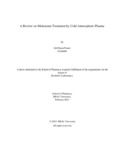A review on melanoma treatment by cold atmospheric plasma

View/
Date
2023-02Publisher
Brac UniversityAuthor
Pranto, Alif HasanMetadata
Show full item recordAbstract
Melanoma is the deadliest form of skin cancer. According to the American Cancer Society, melanoma kills 158,000 people annually. No melanoma vaccine has been approved. "Wide local excision" surgery is used to treat early-stage melanoma. The surgeon removes the tumor and a margin of normal skin. The surgeon will perform a sentinel lymph node biopsy to see if the melanoma has spread. Cold atmospheric plasma (CAP) generates two components: physical and chemical factors. Thermal, UV, and electromagnetic radiation destroy melanoma. RONS— reactive oxygen and nitrogen species—is another factor. Both factors increase immune cell-like T cells and helper T cells like CTD-4 and CTD-8 while decreasing B16F10. To treat B16F10 cell growth, cold atmospheric plasma changes the composition of tyrosine (tyr) and tryptophan (trp). Also, make changes in extracellular tissue pH to induce anti-cancer effects. Cold atmospheric plasma is affordable and easy to utilize, making it ideal for treating cancer cells.
